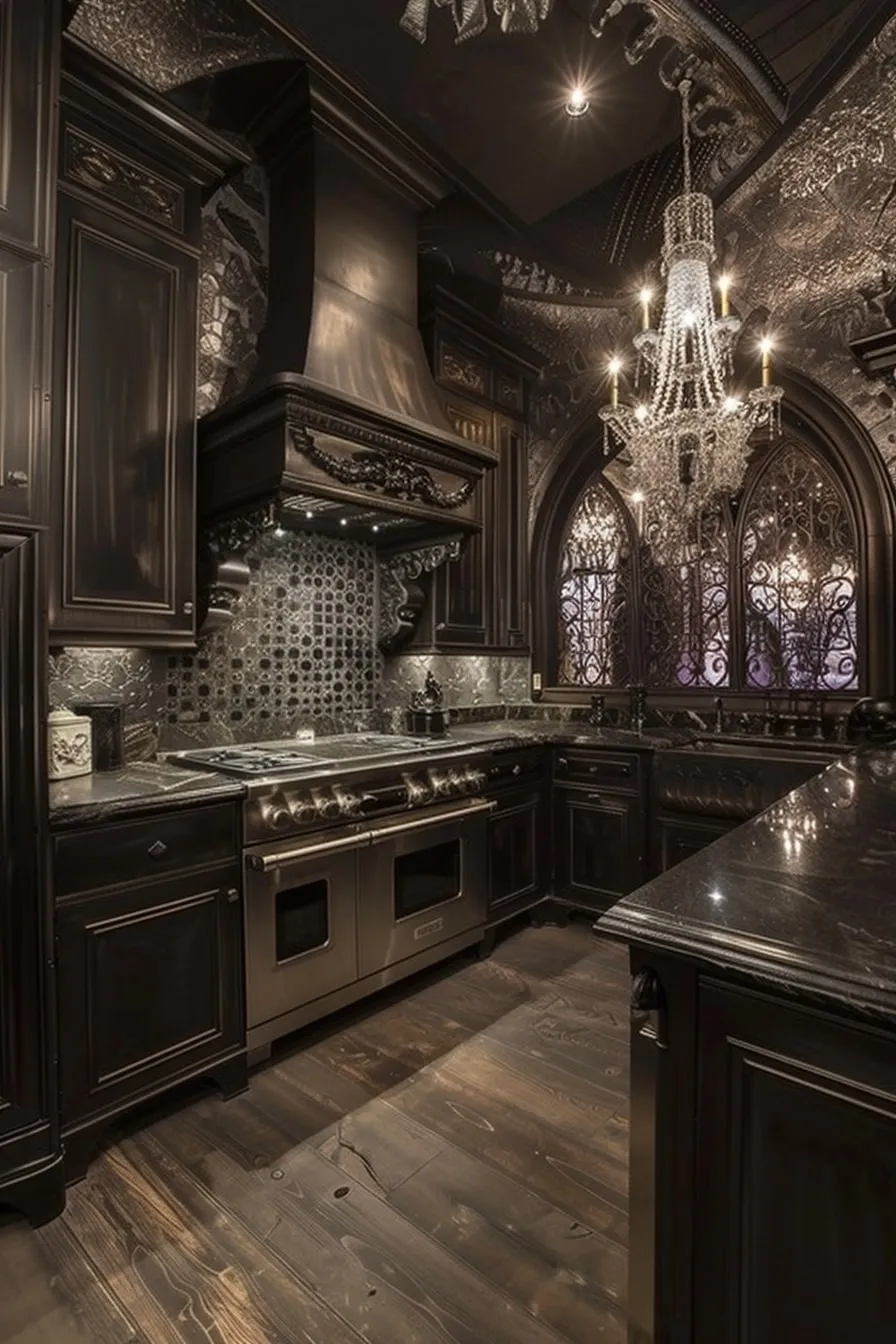Embracing the Dark Side of Design Gothic Kitchen Decor
Gothic kitchen decor offers a unique and captivating aesthetic, transforming the heart of your home into a space of dramatic elegance. This design style, rooted in the architecture and artistry of the medieval period, provides a bold alternative to contemporary and minimalist trends. It’s about embracing rich textures, deep colors, and ornate details to create a kitchen that feels both luxurious and mysterious. The beauty of gothic design lies in its ability to blend history with modern functionality, resulting in a space that is both visually stunning and highly practical. By incorporating the following elements, you can create a gothic kitchen that is not only stylish but also a true reflection of your personality and taste. Prepare to be inspired by the allure of the dark and discover how to infuse your kitchen with gothic charm.
Gothic Kitchen Decor Idea 1 Dramatic Color Palette
The foundation of any gothic kitchen lies in its color scheme. A dramatic and moody palette is essential for setting the tone. Think beyond the typical light and airy kitchen and embrace the darker side. This doesn’t mean your kitchen has to be a black hole it’s about using color to create depth and visual interest. The use of a well-chosen color palette can make a kitchen feel more intimate, cozy, and sophisticated, all hallmarks of the gothic aesthetic.
Deep Wall Colors
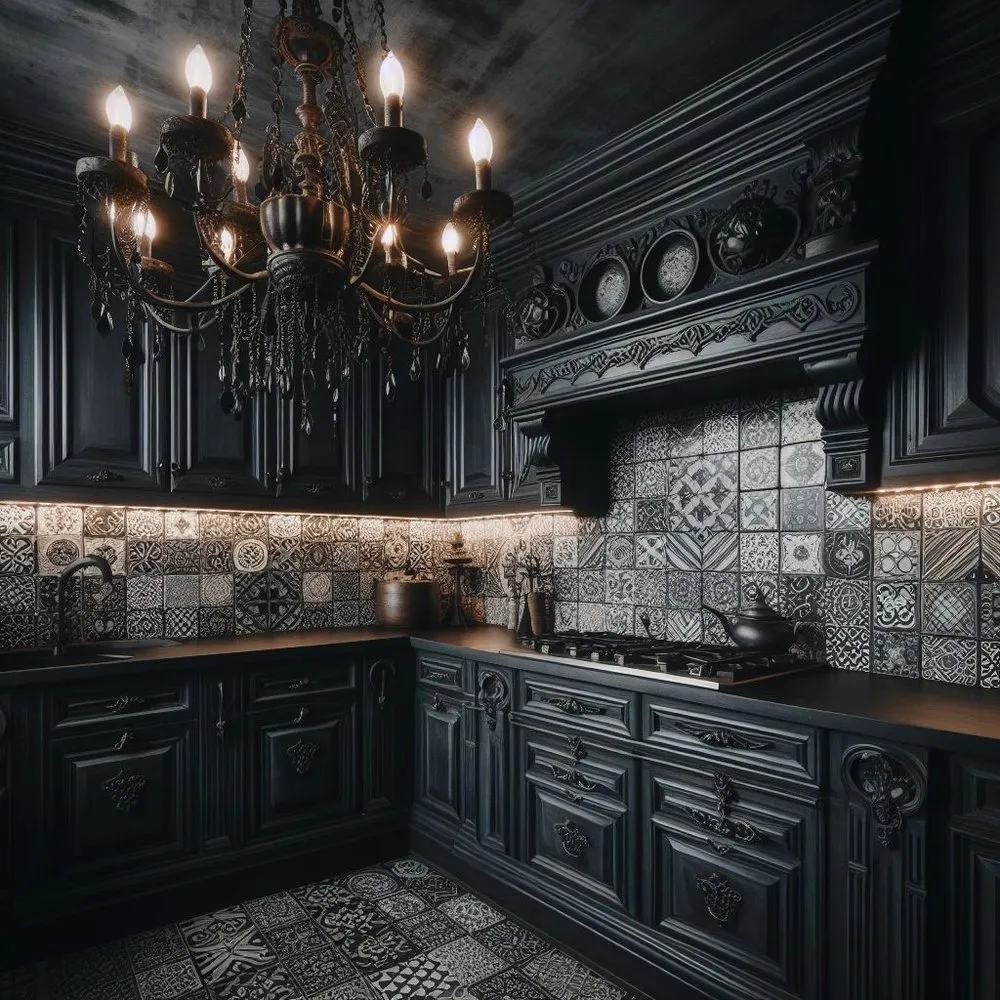
Start with deep, saturated wall colors. Consider shades like charcoal gray, deep burgundy, forest green, or even a rich, dark blue. These colors provide a perfect backdrop for the other elements of the kitchen, making them pop and creating a sense of drama. The key is to choose colors that complement the other design features, such as the cabinetry, countertops, and hardware, ensuring a cohesive and balanced look. Remember that these colors can also create a sense of warmth and coziness, making the kitchen a welcoming space.
Accent Colors
Introduce accent colors to add contrast and visual interest. Metallic finishes like gold, bronze, or copper can add a touch of luxury and elegance. Consider using these in the hardware, lighting fixtures, or even decorative accessories. Jewel tones like emerald green or sapphire blue can also be used to add depth and sophistication. When choosing accent colors, be sure to select shades that complement the primary wall color and enhance the overall gothic aesthetic, without overwhelming the space. Using these accent colors sparingly ensures that the deep wall colors remain the focal point.
Gothic Kitchen Decor Idea 2 Gothic Furnishings
The choice of furnishings plays a crucial role in establishing the gothic style. Opting for furniture that reflects the design’s historical roots can truly transform the look and feel of the kitchen. This often involves choosing pieces that are heavy on detail, with intricate designs and rich materials. The furniture should not only be functional but also serve as decorative elements, contributing to the overall gothic ambiance of the space. Consider both the style and the materials when selecting your kitchen furniture.
Dark Wood Cabinets
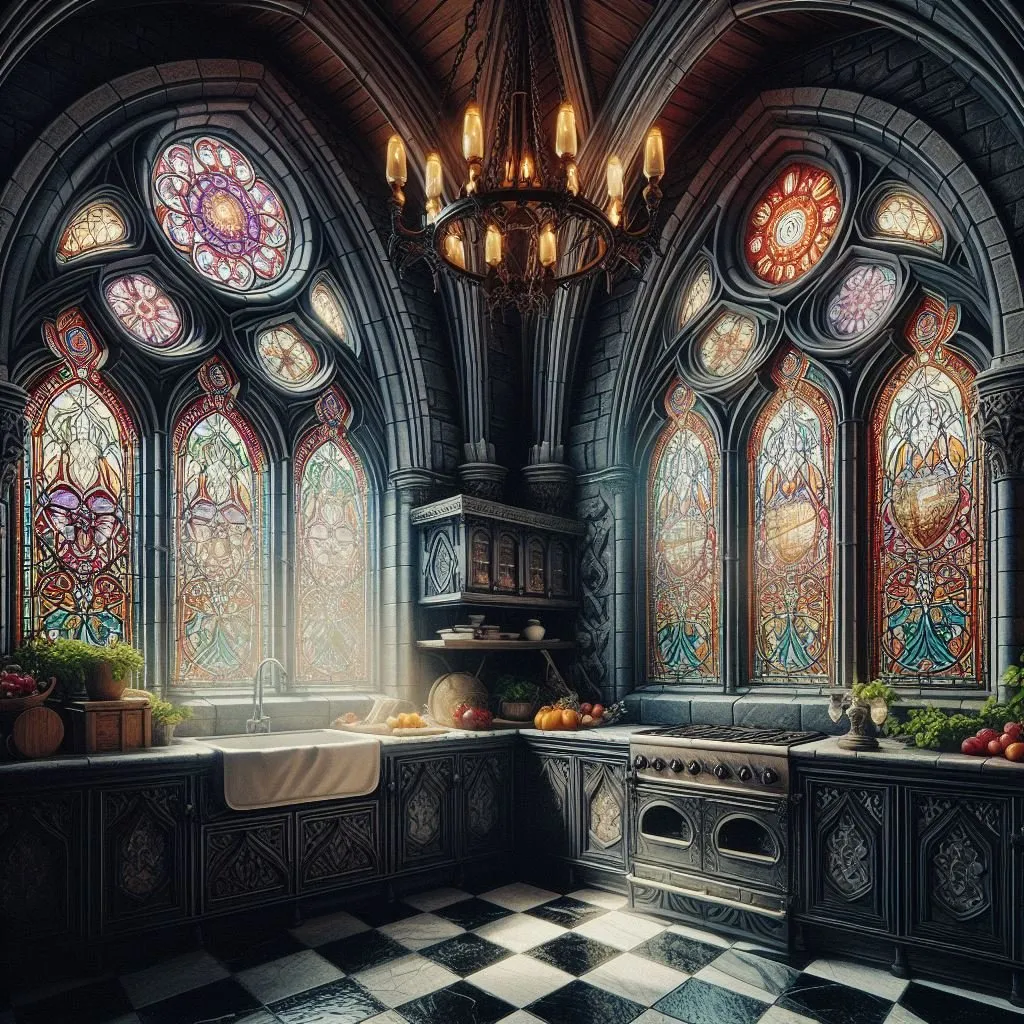
Dark wood cabinets are a cornerstone of the gothic kitchen. Choose cabinets made from woods like mahogany, walnut, or cherry, stained in deep, rich tones. These darker hues provide a striking contrast to lighter countertops and backsplashes and contribute to the overall sense of drama. Consider cabinet styles with raised panels, intricate carvings, or arched details to further enhance the gothic aesthetic. The selection of dark wood cabinetry ensures that the kitchen feels grounded, sophisticated, and in keeping with the historical roots of gothic design.
Ornate Details on Furniture
Look for furniture with ornate details, such as carved embellishments, decorative molding, and gothic arches. These details are essential in conveying the gothic style and add a sense of history and craftsmanship. Consider incorporating a kitchen island with intricate carvings or a dining table with elaborately designed legs. Even the backs of chairs or the sides of stools can feature gothic-inspired designs. These elaborate details are what set the gothic kitchen apart, transforming it into a space that feels both grand and unique.
Gothic Kitchen Decor Idea 3 Statement Lighting
Lighting is an incredibly important element in a gothic kitchen, as it sets the mood and highlights the architectural and decorative details. The right lighting fixtures can dramatically transform the space, enhancing the dramatic effect created by dark colors and ornate furnishings. It is not just about illumination; it’s about the fixtures themselves contributing to the gothic aesthetic. Consider lighting as an integral part of your overall design, choosing fixtures that reflect the historical origins of the style.
Chandeliers
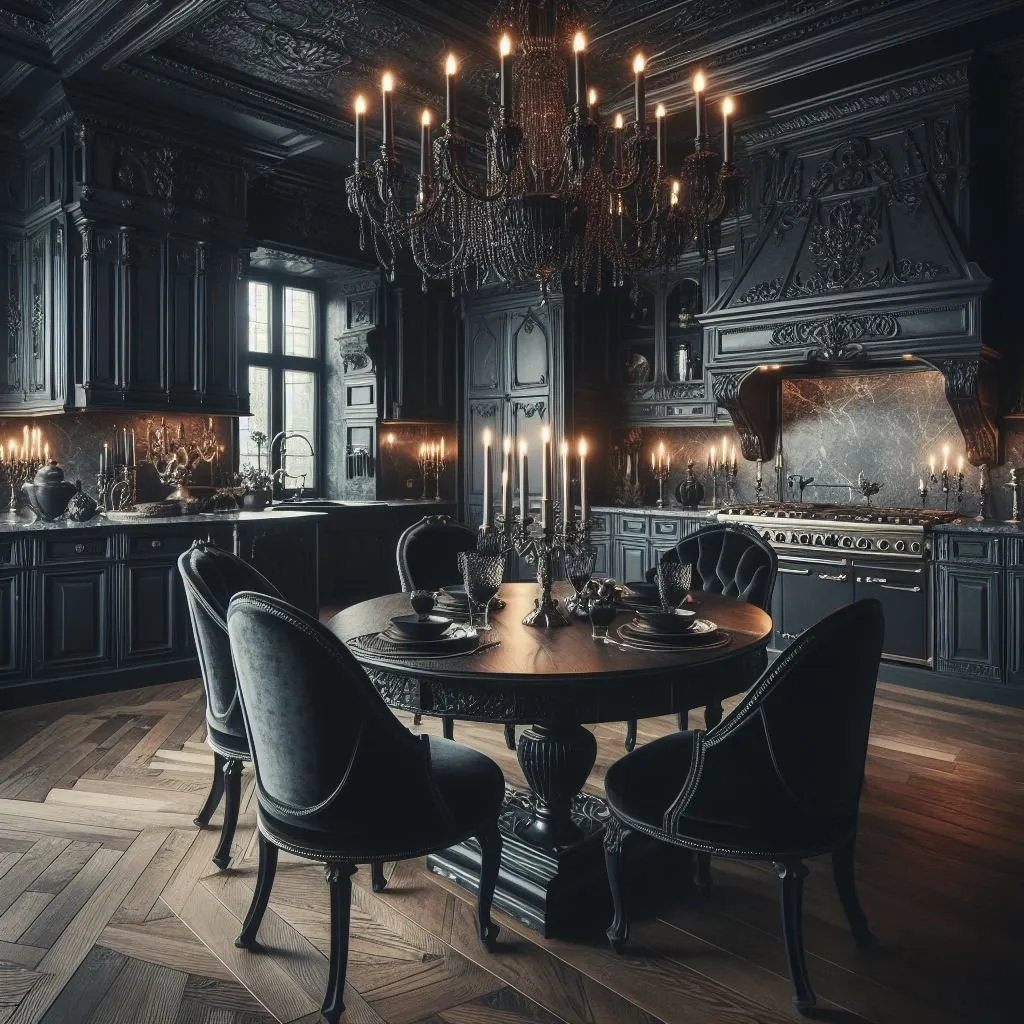
Chandeliers are a quintessential element of gothic decor. Choose a chandelier with an elaborate design, such as wrought iron, crystal, or a combination of materials. The chandelier should be a focal point, hanging above the kitchen island or dining table, providing both light and a dramatic visual impact. The design of the chandelier can draw inspiration from historical gothic elements, such as pointed arches, ornate detailing, or candle-like bulbs. This central fixture is not merely functional it is a statement piece that instantly elevates the gothic feel.
Pendant Lighting
Supplement the chandelier with pendant lighting over the kitchen island or countertops. Opt for pendants with dark metal finishes, such as bronze or black, or choose fixtures with intricate glasswork. Pendant lights can add focused illumination to work areas while also contributing to the overall design. The choice of pendant lighting should complement the chandelier, echoing its style and enhancing the dramatic effect. Consider incorporating pendant lights that feature gothic-inspired shapes or details, such as pointed arches or decorative filigree.
Gothic Kitchen Decor Idea 4 Intricate Hardware
Hardware, often overlooked, plays a vital role in establishing the gothic aesthetic. The details in the hardware can elevate the overall design, adding a touch of elegance and character to the kitchen. Choosing the right hardware can make a significant difference, adding a sense of craftsmanship and historical depth. Consider the materials, finishes, and designs carefully to complement your cabinets and create a cohesive gothic atmosphere.
Dark Metal Finishes
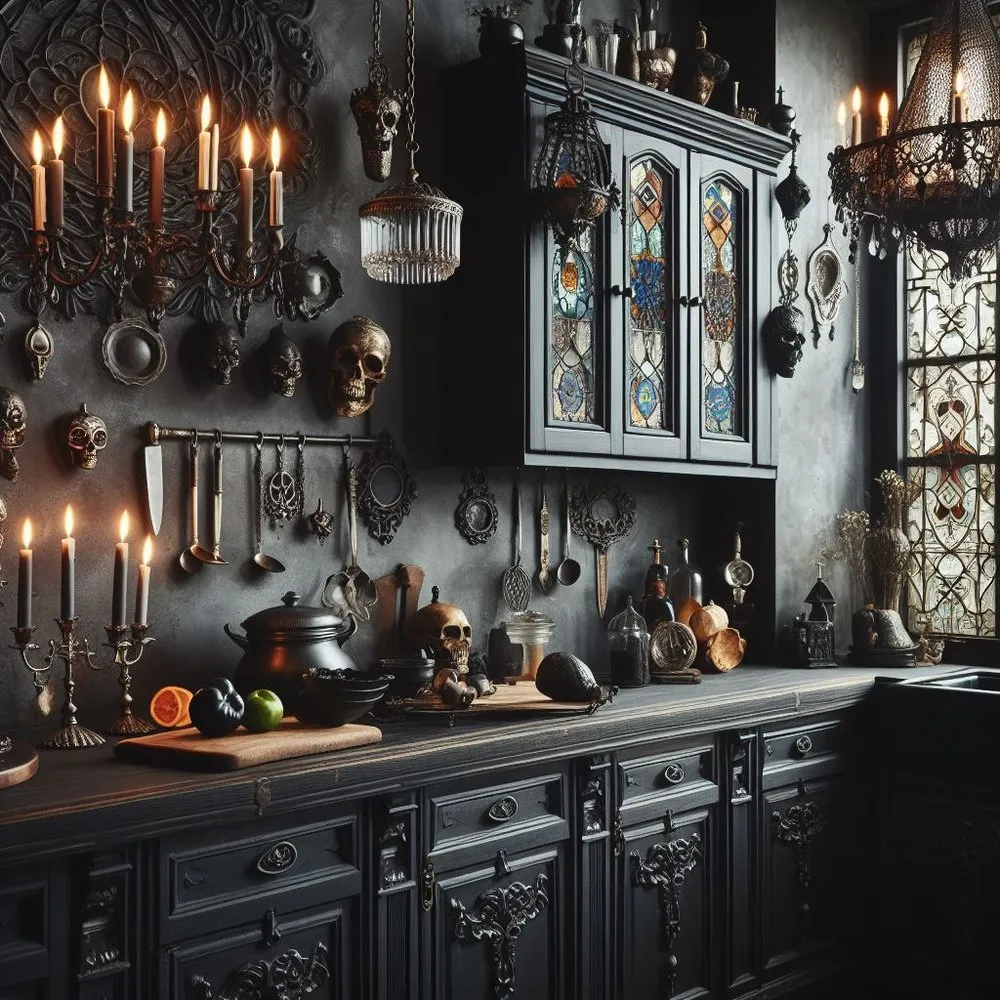
Choose hardware with dark metal finishes, such as wrought iron, antique bronze, or matte black. These finishes complement the dark wood cabinets and contribute to the gothic theme. Avoid shiny or bright finishes that can detract from the overall aesthetic. Instead, opt for finishes that have a slightly aged or weathered look, which adds to the historical feel. These dark metal finishes not only look beautiful but also provide a tactile and visual contrast to the wood.
Elaborate Handle Designs
Look for handles and knobs with elaborate designs, such as gothic arches, fleur-de-lis motifs, or ornate carvings. These details reflect the gothic style’s emphasis on craftsmanship and detail. Consider hardware with intricate patterns and shapes, adding a touch of elegance and sophistication. The hardware should serve as a visual focal point, drawing the eye and contributing to the overall gothic ambiance. These intricate designs can subtly transform your kitchen, emphasizing its gothic roots.
Gothic Kitchen Decor Idea 5 Textured Surfaces
Textures play a crucial role in bringing the gothic style to life in the kitchen. The use of varied surfaces creates visual interest and depth, enhancing the overall design. Incorporating different textures can add a sense of luxury and sophistication. Think about the tactile experience, creating a space that is visually appealing and inviting. From the backsplash to the countertops and walls, the choice of textures will significantly impact the gothic ambiance.
Stone Backsplashes
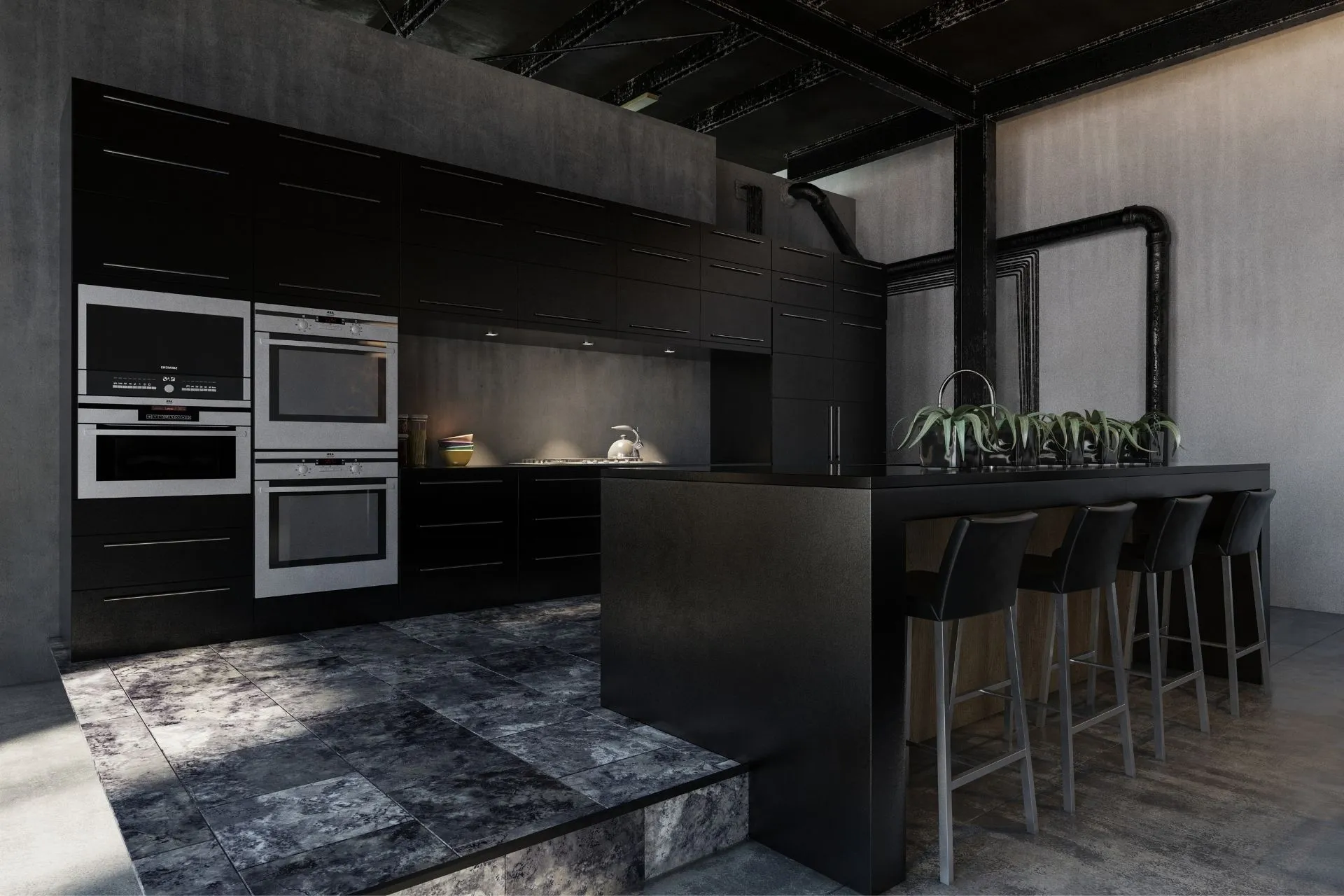
A stone backsplash, such as slate or marble, can add a touch of elegance and a natural, earthy feel to the kitchen. Stone backsplashes are not only visually appealing but also durable and practical. The variations in the stone’s texture and color add depth and visual interest. The choice of stone can complement the cabinets and countertops, creating a cohesive design. Consider a darker stone to match the overall gothic color scheme, enhancing the dramatic effect.
Exposed Brick
Exposed brick is another excellent way to introduce texture and a sense of history into the kitchen. It adds a rustic and industrial touch that complements the gothic style. Exposed brick can be used on a wall, a portion of a wall, or even as a backsplash. The raw and textured surface creates a striking contrast to the smoother elements of the kitchen, adding visual interest and depth. It also brings a unique character to the space, contributing to the gothic aesthetic. Consider brick with a darker hue to enhance the overall dramatic effect.
Gothic Kitchen Decor Idea 6 Gothic Accessories
Accessories are key to adding those finishing touches that tie the whole gothic theme together, creating a cohesive and immersive atmosphere. They allow you to express your personality, while also adding depth, character, and historical context to your space. Think about how these accessories complement the core elements of your kitchen, enhancing the overall gothic design. It’s about more than just decoration it’s about creating a feeling, a mood, and a true gothic kitchen experience.
Candlesticks
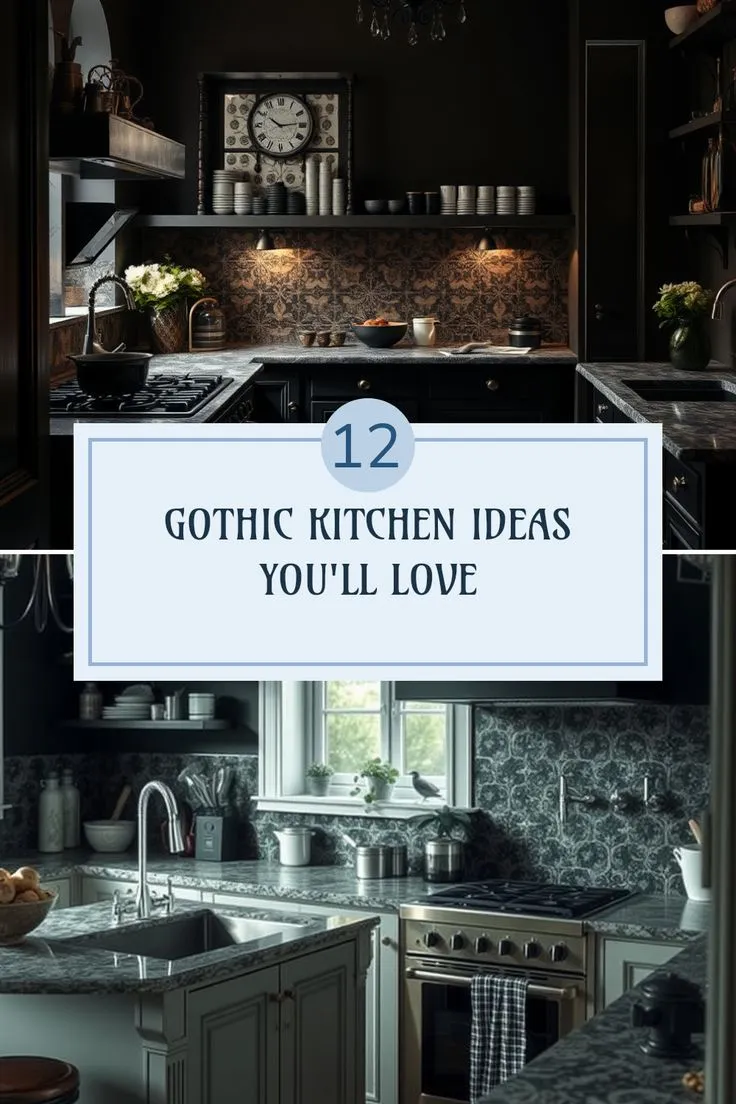
Candlesticks are a must-have accessory for any gothic kitchen. Choose candlesticks made from wrought iron, pewter, or silver, with elaborate designs or gothic detailing. Place them on countertops, shelves, or the dining table to add soft, ambient lighting and a touch of drama. The flickering candlelight adds a sense of mystery and romance, perfect for setting the gothic mood. Consider using different sizes and styles to create a visually interesting arrangement.
Dark Artwork
Adorn your kitchen walls with dark artwork, such as antique portraits, landscape paintings with moody skies, or gothic-inspired prints. Choose frames that complement the overall style, such as ornate gold or dark wood frames. The artwork adds personality and tells a story, enhancing the historical feel of the kitchen. Consider incorporating artwork that reflects the gothic style, such as imagery from medieval times, religious symbols, or mysterious figures. These pieces will draw the eye and add depth to your kitchen design.
Gothic Kitchen Decor Idea 7 Themed Decor Elements
Themed decor elements are the final touches that bring the gothic style to life. Incorporating these details ensures your kitchen is not just inspired by gothic design, but fully immersed in it. It’s about choosing elements that resonate with the core principles of the gothic aesthetic, creating a space that is both authentic and visually stunning. These elements can transform a functional space into a captivating gothic sanctuary.
Medieval Tapestries
If space permits, consider adding medieval tapestries to your kitchen. These can be used as wall hangings or incorporated into the design in other creative ways. Tapestries can add a sense of history and artistry to the space, while also adding texture and visual interest. Look for tapestries with gothic imagery, such as heraldic symbols, medieval scenes, or elaborate floral designs. The colors and textures of the tapestries can complement the overall gothic color scheme, creating a cohesive and immersive environment. These woven artworks also provide a unique historical accent.
Religious Symbols
Religious symbols, such as crosses, statues of saints, or religious paintings, are also appropriate for a gothic kitchen. These symbols reflect the historical roots of the style and add a sense of spiritual depth. Choose pieces that resonate with you personally, and incorporate them into the design in a way that complements the overall aesthetic. Place them on shelves, countertops, or as part of the wall decor. Religious symbols add a unique historical depth, aligning with the gothic design’s connection to the past.
Conclusion The Allure of Gothic Kitchen Decor
Gothic kitchen decor is more than just a design style it’s a statement. It’s about embracing a world of rich colors, ornate details, and a touch of mystery. By following these ideas, you can transform your kitchen into a space that reflects your personality and appreciation for history and elegance. From the deep hues and intricate furnishings to the statement lighting and themed accessories, every element contributes to the captivating gothic atmosphere. Embrace the dark side of design and create a kitchen that is as unique and unforgettable as you are. The gothic kitchen is a testament to the beauty of history, the power of design, and the allure of a truly extraordinary space. It’s a kitchen that isn’t just used, but experienced, celebrated, and cherished.
